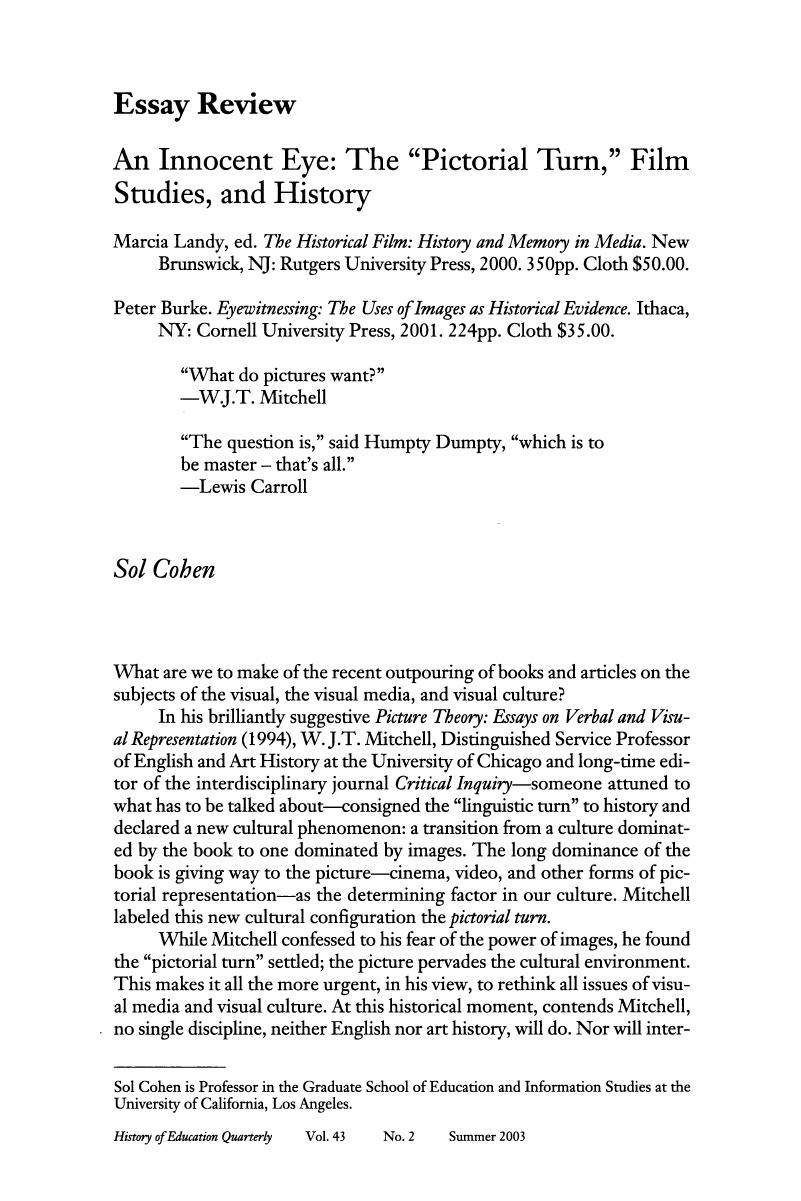Published online by Cambridge University Press: 24 February 2017

1 Devereaux, Leslie and Hillman, Roger, eds. Fields of Vision: Essays in Film Studies, Visual Anthropology, and Photography (Berkeley: University of California Press, 1996), pp. 1–2.Google Scholar
2 Landy is Professor of English and Film Studies at the University of Pittsburgh. The other contributors are: Mbye Cham, African Studies at Howard University; George F. Custen, Theatre and American Studies at City University of New York; Richard Dienst, English at Rutgers; Mary Ann Doane, Culture and Media Studies at Brown; Taylor Downing, Television Producer and Director, BBC, London; Gary Edgerton, Communication and Theatre Arts at Old Dominion University; Naomi Greene, French at California; Miriam Bratu Hansen, Humanities at Chicago; Sue Harper, Film Studies and History, Portsmouth; Sumiko Higashi, History at SUNY-Brockport; Anton Kaes, German at California; Shawn Rosenheim, English at Williams; Robert Rosenstone, History at Cal Tech; Pierre Sorlin, Sociology at Paris; Maria Wyke, Classics at Reading; and Ismail Xavier, Communication at Sao Paulo.Google Scholar
3 See Note 2.Google Scholar
4 Landy, Fascism in Film: Italian Commercial Cinema, 1930–1943 (1986), British Genres: British Cinema and Society (1991), and Cinematic Uses of the Past (1996); Cham, African Experiences of Cinema (1996); Custen, Bio/Pics: How Hollywood Constructed Public History (1992); Doane, Femmes Fatales: Feminism, Film Theory, and Psychoanalysis (1991); Greene, Landscapes of Loss: The National Past in Postwar French Cinema (1999); Hansen, Babel and Babylon: Spectatorship in American Silent Film (1991); Harper, Picturing the Past: The Rise and Fall of the British Costume Film (1994); Higashi, Cecil B. DeMille and American Culture: The Silent Era (1994); Kaes, From Hitler to Heimat: The Return of History as Film (1989); Rosenstone, Visions of the Past: The Challenge of Film to Our Idea of History (1995); Sorlin, Film in History: Restaging the Past (1980); Wyke, Projecting the Past: Ancient Rome, Cinema, and History (1997); and Xavier, Allegories of Underdevelopment: Aesthetics and Politics in Modern Brazilian Cinema (1997).Google Scholar
5 Screen; Post Script; Jump Cut; Film Criticism; Film Quarterly; Literature-Film Quarterly; Afterimage; Wide Angle; Cineaste; Journal of Popular Film and Television; Film Comment; Film Journal; Film Journal International; Cinema Journal; Sight and Sound; Historical Journal of Film, Radio, and Television; Film and History; Cinefocus; East/West Film Journal; Quarterly Review of Film Studies, and Quarterly Review of Film and Video. Google Scholar
6 Landy, Marcia “Film and English/American Studies: What Are We Doing in an English Department?“ Critical Quarterly 39 (1997), pp. 42–50.Google Scholar
7 See, for example: Robert Sklar and Charles Musser, eds., Resisting Images: Essays on Cinema and History (1990); Mark C. Carnes, ed., Past Imperfect: History According to the Movies (1996); Robert B. Toplin, History by Hollywood: The Use and Abuse of the American Past (1996); Vivian Sobchack, ed., The Persistence of History (1996); Tony Barta, ed., Screening the Past: Film and the Representation of History (1998); and Natalie Zemon Davis, Slaves on Screen: Film and Historical Vision (2000).Google Scholar
8 See Note 7.Google Scholar
9 See Note 7.Google Scholar
10 Peter Burke's books prior to Eyewitnessing include: History and Social Theory (1992); The Fabrication of Louis XIV (1992); Varieties of Cultural History (1997); The European Renaissance: Centres and Peripheries (1998); A Social History of Knowledge: From Gutenberg to Diderot (2000); and an edited volume, New Perspectives on Historical Writing (1991). ______Google Scholar
11 For corroboration, Burke cites a handful of books: Francis Haskell, History and its Images (1993); Simon Schama, The Embarrassment of Riches (1987); Robert M. Levine, Images of History (1989); David Freedberg, The Power of Images (1989); and Jay Ruby, Picturing Culture (2000). He also notes the surge of interest in film and film reviews in the major journals in history and the humanities, such as American Historical Review, Journal of Interdisciplinary History, Past and Present, History and Theory, and Critical Inquiry. Google Scholar
12 Burke's positive examples include, by director and title: Luccino Visconte, The Leopard (1963); Federico Fellini, Roma (1972); Miklos Jansco, The Red and the White (1967); Roberto Rossellini, Louis XIV(1966); Bo Widerberg, Adalen (1969); Bernardo Bertolucci, Novacenta (1976); and Daniel Vigne, The Return of Martin Guerre (1982).Google Scholar
13 See also Carlo Ginzburg, Clues, Myths, and the Historical Method (1989).Google Scholar